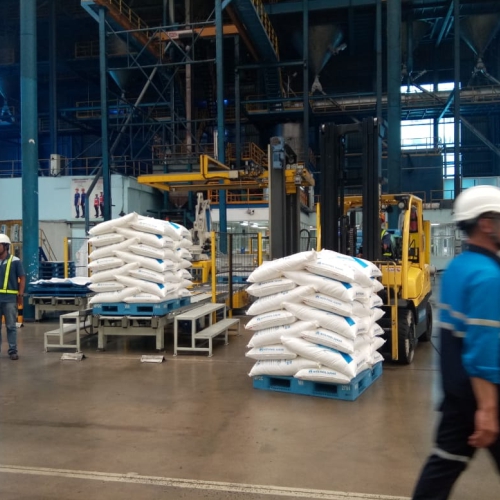The Indian sugar industry is currently grappling with a complex web of economic and regulatory challenges that threaten to significantly impact the Fair and Remunerative Price (FRP) of sugarcane in the upcoming season. This analysis sheds light on the major factors contributing to this difficult situation.
Central Government Regulations:
Curtailed Ethanol Production: The central government’s curbs on ethanol production from juice syrup and B-heavy molasses in December 2023, coupled with a ban on sugar exports implemented in June 2023, have led to a surplus of domestic sugar stocks. This increased availability has caused domestic sugar prices to plummet.
Escalating Production Costs:
The tripartite agreement with sugarcane cutting laborers has significantly increased cutting and transportation costs by Rs. 100-125 per tonne, squeezing profit margins further as wages and maintenance expenses also rise.
Stagnant Minimum Selling Price (MSP):
Despite the upward movement in production costs, the MSP of sugar remains stagnant. This stagnation, combined with suboptimal operation or closure of ethanol plants due to policy changes, is putting a significant financial strain on sugar mills. Repayment of loans taken for ethanol plant construction is threatened by the lack of ongoing revenue from ethanol production, raising the risk of sugar factory loan accounts becoming non-performing assets (NPAs).
Sugarcane Production and Harvesting:
Declining Production in Maharashtra: Despite advances paid to labor gangs, worker shortages are hindering sugarcane production in Maharashtra, a key producer.
Impact of Mechanization: Increased dependence on mechanical harvesters has resulted in higher trash content in sugarcane, leading to lower sugar yields.
Government Quotas and Market Dynamics:
Sugar Quotas and Depleting Stocks: In an attempt to stabilize domestic sugar prices, the government has been incrementally increasing sugar quotas for monthly sales by mills throughout 2024. However, this measure, along with the obligation on mills to sell sugar at fixed intervals, has resulted in depleting stocks at factories while stocks held by traders are increasing. Additionally, with the upcoming Lok Sabha elections in May 2024, sugar prices are expected to rise, potentially benefiting traders who hold larger stockpiles and have the potential to speculate on prices, at the expense of mills.
Environmental Factors:
El Niño Threat: The anticipated El Niño event later in 2024 is likely to reduce sugar and ethanol production in the coming year. This environmental factor, combined with the prevailing economic and regulatory challenges, suggests a potentially difficult period ahead for sugar mills.
Ethanol Stocks and Economic Implications:
Unsold Ethanol Reserves: Ethanol producers who complied with court orders or government directives for ethanol production prior to the recent policy changes are now facing the issue of unsold ethanol reserves due to the lack of offtake by Oil Marketing Companies (OMCs). This has resulted in a financial crisis for producers as they grapple with rising interest on loans taken to pay for sugarcane.
Approach to FRP Payment:
Short-Term Relief, Long-Term Concerns: With Lok Sabha and Assembly elections looming, FRP payments by sugar mills have been largely met, often through increased borrowing. However, the potential decline in sugar and ethanol production anticipated due to reduced rainfall next season, coupled with the increased FRP, could threaten the long-term financial stability of sugar mills.
Impact of Compulsory Jute Packaging Order:
Increased Packaging Costs: In accordance with the Compulsory Jute Packaging Order, the central government has mandated that sugar mills purchase jute bags for packaging 20% of their sugar output. The cost of jute bags, ranging from Rs. 120-125 per quintal, is significantly higher compared to PP bags, which cost Rs. 32-35 per quintal. This substantial difference in packaging expenses has further eroded the profit margins of sugar mills.
Impact of C Heavy Molasses (CHM) Policy:
Price Slump and Limited Options: The government’s push for CHM-based ethanol production has created a saturated market, leading to a significant drop in CHM prices. This shift has particularly impacted producers who lack the infrastructure to utilize alternative feedstocks for ethanol. With the ban on ethanol production from SCJ and BHM, these producers are left with limited options: either produce ethanol from CHM or face a loss on their existing stocks. Furthermore, this policy change has resulted in a domino effect, causing a substantial price drop in the market for potable alcohol derivatives like ENA (Extra Neutral Alcohol) and EQRS (Extra Quality Rectified Spirit).
Export Restrictions and Stockpile Buildup: To prevent further price decline through exports, the government imposed an export duty on CHM. While this aims to protect domestic prices, it has resulted in a buildup of CHM at factories, creating additional storage and financial burdens for producers
Recommendations
The Indian sugar industry faces a multitude of challenges, and navigating a path to long-term sustainability requires a multi-pronged approach. Here are some potential recommendations:
Government Policy:
Increase MSP:
An increase in the Minimum Selling Price (MSP) of sugar, aligned with the rise in FRP, could offer some relief to sugar mills facing financial strain. Following are the potential consequences:
Improved Profit Margins for Sugar Mills: A higher MSP, if implemented alongside a rise in FRP, would help bridge the gap between production costs and selling price. This could improve the financial health of sugar mills, allowing them to make necessary investments in modernization and expansion.
Potential Impact on Consumer Prices: An increase in MSP could lead to a moderate rise in domestic sugar prices. However, the government can utilize various tools, such as buffer stocks and calibrated release mechanisms, to mitigate significant price fluctuations and ensure affordability for consumers.
Export Competitiveness: The impact of an increased MSP on exports depends on the extent of the rise and global market conditions. If the increase is carefully calibrated, it may not significantly affect export competitiveness.
Review of Compulsory Jute Packaging Order: The government should consider revising the Compulsory Jute Packaging Order. A possible solution could be to reduce the mandatory percentage of jute packaging or introduce a subsidy to offset the higher cost of jute bags compared to PP bags. This would provide some relief to sugar mills without significantly impacting the jute industry.
Long-term Ethanol Policy Framework: The government should establish a clear and stable long-term policy framework for ethanol production. This framework should provide certainty to investors and encourage the expansion of ethanol production capacity based on realistic demand projections.
Focus on Collaborative Approach: Policymakers can play a crucial role in facilitating a more collaborative approach within the industry. Bringing together sugarcane farmers, mill owners, and ethanol producers to discuss challenges and potential solutions could lead to more sustainable practices across the sugar value chain.
Industry Initiatives:
Cost Reduction Measures: Sugar mills need to explore cost-reduction measures across their operations. This could involve optimizing logistics, adopting energy-efficient technologies, and streamlining production processes. Additionally, exploring alternative, lower-cost packaging materials that meet quality and sustainability standards could be beneficial.
Diversification Strategies: Sugar mills can explore diversification strategies to mitigate risks and create new revenue streams. This could involve venturing into production of co-generation power plants, value-added sugar products, or bio-fertilizers.
Investment in Research and Development: Increased investment in research and development (R&D) is crucial for the industry’s long-term competitiveness. Focusing on areas like improved sugarcane varieties, more efficient ethanol production processes, and innovative waste management solutions can lead to significant gains.
Conclusion:
The Indian sugar industry is at a crossroads. By acknowledging the complex challenges it faces and implementing a combination of well-crafted government policies and proactive industry initiatives, there is a path forward towards a more resilient and sustainable future. Collaboration, innovation, and a long-term vision are key to ensuring the industry’s continued contribution to the Indian economy and the livelihoods of millions of people who depend on it.
Disclaimer: The views and opinions expressed in the article by Dilip Patil, Managing Director of Samarth SSK Ltd., are solely his own.













